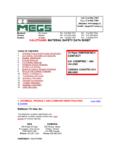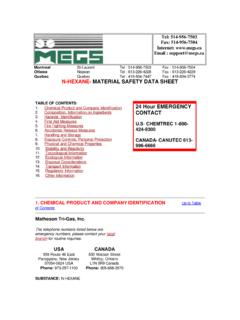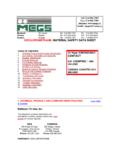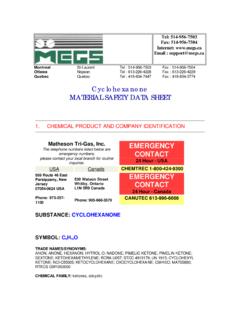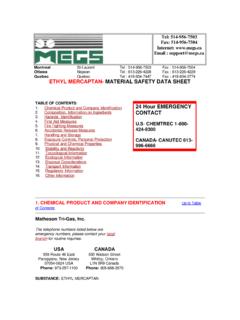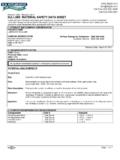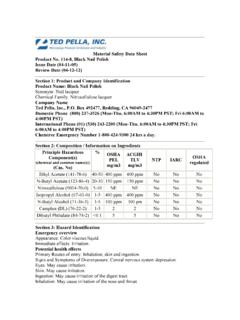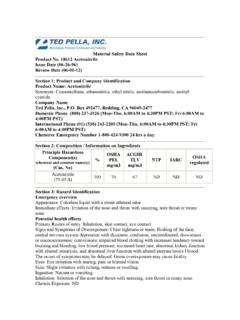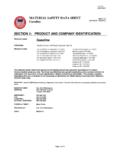Transcription of ACETONITRILE- MATERIAL SAFETY DATA SHEET
1 Tel: 514-956-7503 Fax: 514-956-7504 Internet: E-mail: Montreal St-Laurent Tel : 514-956-7503 Fax : 514-956-7504 Ottawa Nepean Tel : 613-226-4228 Fax : 613-226-4229 Quebec Quebec Tel : 418-834-7447 Fax : 418-834-3774 acetonitrile - MATERIAL SAFETY data SHEET TABLE OF CONTENTS: 1. Chemical Product and Company Identification 2. Composition, Information on Ingredients 3. Hazards Identification 4. First Aid Measures 5. Fire Fighting Measures 6. Accidental Release Measures 7. Handling and Storage 8. Exposure Controls, Personal Protection 9. Physical and Chemical Properties 10. Stability and Reactivity 11.
2 Toxicological Information 12. Ecological Information 13. Disposal Considerations 14. Transport Information 15. Regulatory Information 16. Other Information 24 Hour EMERGENCY CONTACT CHEMTREC 1-800-424-9300 CANADA- CANUTEC 613-996-6666 1. CHEMICAL PRODUCT AND COMPANY IDENTIFICATION-----------Up to Table of Contents Matheson Tri-Gas, Inc. The telephone numbers listed below are emergency numbers, please contact your local branch for routine inquiries. USA 959 Route 46 East Parsippany, New Jersey 07054-0624 USA Phone: 973-257-1100 CANADA 530 Watson Street Whitby, Ontario L1N 5R9 Canada Phone: 905-668-3570 SUBSTANCE: acetonitrile SYMBOL: CH3CN TRADE NAMES/SYNONYMS: CYANOMETHANE; ETHANENITRILE; ETHYL NITRILE; METHANECARBONITRILE; METHYL CYANIDE; RCRA U003; STCC 4907405; UN 1648; A-999; A-998; A-24; O-1034; A-21; C2H3N; MAT00170; RTECS AL7700000 CHEMICAL FAMILY: nitriles, aliphatic CREATION DATE: Jan 24 1989 REVISION DATE: Mar 16 1999 2.
3 COMPOSITION, INFORMATION ON INGREDIENTS-----------Up to Table of Contents COMPONENT: acetonitrile CAS NUMBER: 75-05-8 EC NUMBER (EINECS): 200-835-2 EC INDEX NUMBER: 608-001-00-3 PERCENTAGE: 100 3. HAZARDS IDENTIFICATION-----------Up to Table of Contents NFPA RATINGS (SCALE 0-4): HEALTH=2 FIRE=3 REACTIVITY=0 EC CLASSIFICATION (ASSIGNED): F Highly Flammable T Toxic R 11-23/24/25 EC Classification may be inconsistent with independently-researched data . EMERGENCY OVERVIEW: Color: colorless Physical Form: liquid Odor: sweet odor Major Health Hazards: respiratory tract irritation, eye irritation Physical Hazards: Flammable liquid and vapor.
4 Vapor may cause flash fire. POTENTIAL HEALTH EFFECTS: INHALATION: Short Term Exposure:irritation, nausea, stomach pain, loss of voice, chest and stomach pain, wheezing, headache, symptoms of drunkenness, disorientation, suffocation, convulsions, coma Long Term Exposure: lung damage SKIN CONTACT: Short Term Exposure: same as effects reported in short term inhalation, irritation, suffocation Long Term Exposure: same as effects reported in short term exposure EYE CONTACT: Short Term Exposure: irritation, tearing Long Term Exposure: same as effects reported in short term exposure INGESTION: Short Term Exposure.
5 Same as effects reported in short term inhalation, bluish skin color, suffocation, coma Long Term Exposure: no information on significant adverse effects CARCINOGEN STATUS: OSHA: N NTP: N IARC: N 4. FIRST AID MEASURES-----------Up to Table of Contents INHALATION: Remove from exposure immediately. Use a bag valve mask or similar device to perform artificial respiration (rescue breathing) if needed. Get medical attention. SKIN CONTACT: Remove contaminated clothing, jewelry, and shoes immediately. Wash with soap or mild detergent and large amounts of water until no evidence of chemical remains (at least 15-20 minutes).
6 Get medical attention, if needed. EYE CONTACT: Wash eyes immediately with large amounts of water or normal saline, occasionally lifting upper and lower lids, until no evidence of chemical remains. Get medical attention immediately. ANTIDOTE: amyl nitrite, inhalation; sodium nitrite, intravenous; sodium thiosulfate, infusion; oxygen. 5. FIRE FIGHTING MEASURES-----------Up to Table of Contents FIRE AND EXPLOSION HAZARDS: Severe fire hazard. Vapor/air mixtures are explosive. The vapor is heavier than air. Vapors or gases may ignite at distant ignition sources and flash back. EXTINGUISHING MEDIA: alcohol resistant foam, carbon dioxide, regular dry chemical, water, alcohol resistant foam Large fires: Use alcohol-resistant foam or flood with fine water spray.
7 FIRE FIGHTING: Move container from fire area if it can be done without risk. Dike for later disposal. Do not scatter spilled MATERIAL with high-pressure water streams. Cool containers with water spray until well after the fire is out. Stay away from the ends of tanks. Withdraw immediately in case of rising sound from venting SAFETY device or any discoloration of tanks due to fire. For tank, rail car or tank truck, evacuation radius: 800 meters (1/2 mile). Water may be ineffective. FLASH POINT: 43 F (6 C) (OC) LOWER FLAMMABLE LIMIT: 3% UPPER FLAMMABLE LIMIT: 16% AUTOIGNITION: 975 F (524 C) FLAMMABILITY CLASS (OSHA): IB 6.
8 ACCIDENTAL RELEASE MEASURES-----------Up to Table of Contents OCCUPATIONAL RELEASE: Avoid heat, flames, sparks and other sources of ignition. Do not touch spilled MATERIAL . Stop leak if possible without personal risk. Reduce vapors with water spray. Small spills: Absorb with sand or other non-combustible MATERIAL . Collect spilled MATERIAL in appropriate container for disposal. Large spills: Dike for later disposal. Remove sources of ignition. Keep unnecessary people away, isolate hazard area and deny entry. Reportable Quantity (RQ): Notify Local Emergency Planning Committee and State Emergency Response Commission for release greater than or equal to RQ ( SARA Section 304).
9 If release occurs in the and is reportable under CERCLA Section 103, notify the National Response Center at (800)424-8802 (USA) or (202)426-2675 (USA). 7. HANDLING AND STORAGE-----------Up to Table of Contents Store and handle in accordance with all current regulations and standards. Subject to storage regulations: OSHA 29 CFR Protect from physical damage. Store outside or in a detached building. Inside storage: Store with flammable liquids. Keep separated from incompatible substances. Grounding and bonding required. Keep separated from incompatible substances. 8. EXPOSURE CONTROLS, PERSONAL PROTECTION-----------Up to Table of Contents EXPOSURE LIMITS: acetonitrile : 40 ppm (70 mg/m3) OSHA TWA 60 ppm (105 mg/m3) OSHA STEL (vacated by 58 FR 35338, June 30, 1993) 40 ppm (67 mg/m3) ACGIH TWA 60 ppm (101 mg/m3) ACGIH STEL 20 ppm (34 mg/m3) NIOSH recommended TWA VENTILATION: Provide local exhaust ventilation system.
10 Ventilation equipment should be explosion-resistant if explosive concentrations of MATERIAL are present. Ensure compliance with applicable exposure limits. EYE PROTECTION: Wear splash resistant SAFETY goggles with a faceshield. Provide an emergency eye wash fountain and quick drench shower in the immediate work area. CLOTHING: Wear appropriate chemical resistant clothing. GLOVES: Wear appropriate chemical resistant gloves. RESPIRATOR: The following respirators and maximum use concentrations are drawn from NIOSH and/or OSHA. 200 ppm Any chemical cartridge respirator with organic vapor cartridge(s). Any supplied-air respirator.
